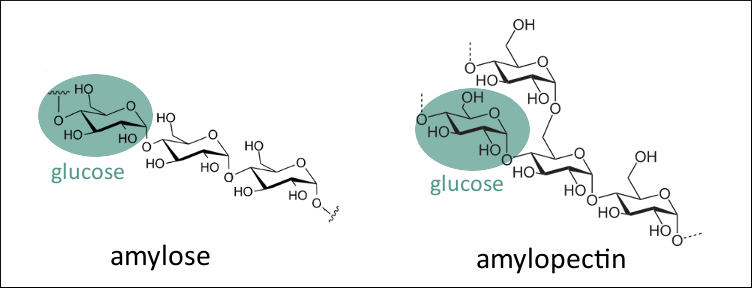What Does This Test Tell You About The Chemical Makeup Of Glucose And Starch
Iodine Examination
Using iodine to test for the presence of starch is a common experiment. A solution of iodine (Itwo) and potassium iodide (KI) in h2o has a light orange-brownish color. If it is added to a sample that contains starch, such equally the bread pictured above, the color changes to a deep blue. But how does this color change work?
Starch is a carbohydrate found in plants. It consists of two dissimilar types of polysaccharides that are made up of glucose units which are connected in two dissimilar ways. One is the linear amylose and the other is the branched amylopectin (pictured below).

Amylose is the chemical compound that is responsible for the bluish color. Its chain forms a helix shape, and iodine tin can be bound inside this helix (pictured below).
.jpg)
Charge-Transfer Complexes
The colors are caused by so-called charge transfer (CT) complexes. Molecular iodine (I2) is not easily soluble in water, which is why potassium iodide is added. Together, they form polyiodide ions of the blazon In –, for example, Iiii –, I5 –, or I7 –. The negatively charged iodide in these compounds acts every bit accuse donor, the neutral iodine as a charge acceptor. Electrons in such charge-transfer complexes are easy to excite to a higher free energy level by light. The low-cal is absorbed in the procedure and its complementary colour is observed by the human eye.
In the case of the aqueous solution of polyiodides, the absorptions of the different species atomic number 82 to an overall brownish color. One time amylose is added, it forms another CT circuitous, Here, the amylose acts as a charge donor and the polyiodide as an acceptor. This complex absorbs light of a different wavelength than polyiodide, and the colour turns nighttime blue.
Polyiodide Chains
The exact structure of the polyiodides inside the amyloid helix is not articulate. The amylose-iodine circuitous is amorphous (i.due east., information technology does non form ordered crystals), which has made it difficult to determine its structure. It has been proposed that the species within the helix are repeated I3 – or I5 – units.
However, Ram Seshadri, Fred Wudl, and colleagues, University of California, Santa Barbara, United states of america, take found evidence that infinite polyiodide chains In ten– are contained in the amylose-iodine complex [1]. The team investigated a related system, a pyrroloperylene–iodine complex, to study its backdrop every bit an organic electronic conductor. The material is crystalline, and therefore, the team was able to make up one's mind its structure using X-ray crystallography. They found nearly linear polyiodide chains in-between stacks of pyrroloperylene. It turned out that the cloth containing these chains absorbs light at very similar wavelengths to the amylose-iodine complex, which supports the hypothesis that similar polymeric chains form in the iodine test for starch.
Reference
- [ane] Infinite Polyiodide Bondage in the Pyrroloperylene-Iodine Complex: Insights into the Starch-Iodine and Perylene-Iodine Complexes,
Sheri Madhu, Hayden A. Evans, Vicky 5. T. Doan-Nguyen, John G. Labram, Guang Wu, Michael L. Chabinyc, Ram Seshadri, Fred Wudl,
Angew. Chem. Int. Ed. 2016, 55, 8032–8035.
DOI: ten.1002/anie.201601585
Sources
- Der Iod-Stärke-Komplex (in German),
www.chemieunterricht.de 2006.
(accessed November 24, 2016) - The structure of the blue starch-iodine complex,
Wolfram Saenger,
Naturwissenschaften 1984, 71, 31–36.
DOI: ten.1007/bf00365977
Article Information
DOI: 10.1002/chemv.201600103
Article Views: 624615
What Does This Test Tell You About The Chemical Makeup Of Glucose And Starch,
Source: https://www.chemistryviews.org/details/education/10128441/Why_Does_Iodine_Turn_Starch_Blue.html
Posted by: littlethatuligh.blogspot.com


0 Response to "What Does This Test Tell You About The Chemical Makeup Of Glucose And Starch"
Post a Comment